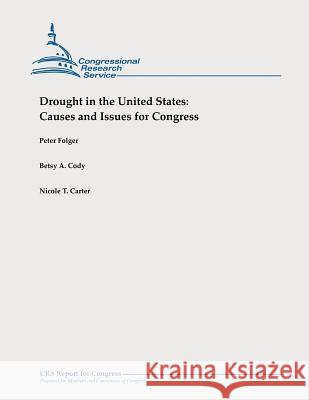Drought in the United States: Causes and Issues for Congress » książka
Drought in the United States: Causes and Issues for Congress
ISBN-13: 9781478326809 / Angielski / Miękka / 2012 / 30 str.
Drought is a natural hazard with potentially significant societal, economic, and environmental consequences. Public policy issues related to drought range from how to identify and measure drought to how best to prepare for, respond to, and mitigate drought impacts, and who should bear such costs. This report provides information relevant to drought policy discussions by describing the physical causes of drought, drought history in the United States, examples of regional drought conditions, and policy challenges related to drought. What is drought? Drought is commonly defined as a lack of precipitation over an extended period of time, usually a season or more, relative to some long-term average condition. While the technology and science to predict droughts have improved, regional predictions remain limited to a few months in advance. History suggests that severe and extended droughts are inevitable and part of natural climate cycles. What causes drought? The physical conditions causing drought in the United States are increasingly understood to be linked to sea surface temperatures (SSTs) in the tropical Pacific Ocean. Studies indicate that cooler-than-average SSTs have been connected to the severe western drought in the first decade of the 21st century, severe droughts of the late 19th century, and precolonial North American "megadroughts." The 2011 severe drought in Texas is thought to be linked to La Nina conditions in the Pacific Ocean. What is the future of drought in the United States? The prospect of extended droughts and more arid baseline conditions in parts of the United States could suggest new challenges to federal water projects, which were constructed largely on the basis of 20th century climate conditions. Some studies suggest that the American West may be transitioning to a more arid climate, possibly resulting from the buildup of greenhouse gases in the atmosphere, raising concerns that the region may become more prone to extreme drought it was in the 20th century. Some models of future climate conditions also predict greater fluctuations in wet and dry years. California's 2007-2009 drought exacerbated ongoing tensions among competing water uses. While drought is most common in California and the Southwest, drought also can exacerbate water tensions in other regions. For example, the 2007-2008 drought in the Southeast heightened a long-standing dispute in the Apalachicola-Chattahoochee-Flint River (ACF) basin. Both California and the ACF are again experiencing drought conditions, as are the Rio Grande and Upper Colorado River basins. What are some drought policy challenges? Although the impacts of drought can be significant nationally as well as regionally, comprehensive national drought policy does not exist. Developing such a policy would represent a significant challenge because of split federal and non-federal responsibilities, the existing patchwork of federal drought programs, and differences in regional conditions and risks. While a comprehensive national policy has not been enacted, Congress has considered and acted upon some of the recommendations issued by the National Drought Policy Commission in 2000. In coming years, Congress may review how federal agencies such as the U.S. Army Corps of Engineers and the Bureau of Reclamation respond to droughts. Congress may also assess other federal programs or choose to reassess the National Drought Policy Commission's recommendations."
Zawartość książki może nie spełniać oczekiwań – reklamacje nie obejmują treści, która mogła nie być redakcyjnie ani merytorycznie opracowana.











